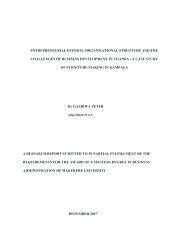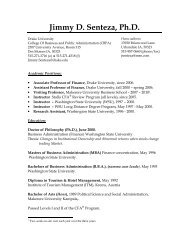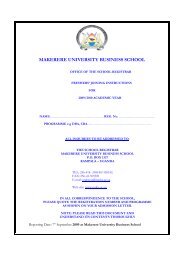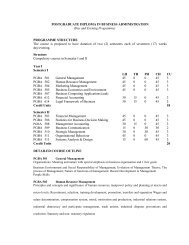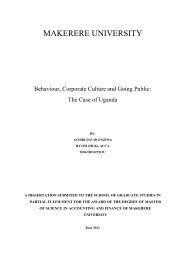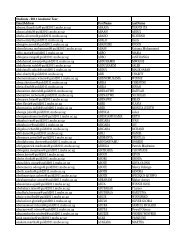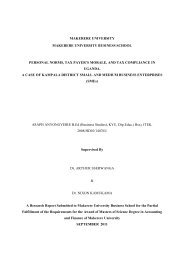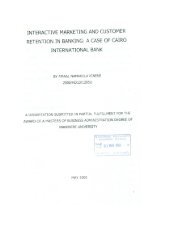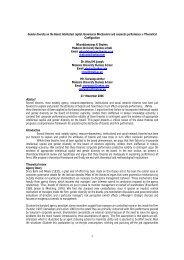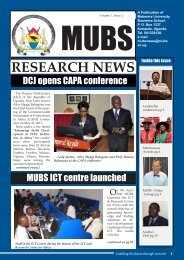Corruption and the Smallholder - Makerere University Business ...
Corruption and the Smallholder - Makerere University Business ...
Corruption and the Smallholder - Makerere University Business ...
Create successful ePaper yourself
Turn your PDF publications into a flip-book with our unique Google optimized e-Paper software.
<strong>Corruption</strong> <strong>and</strong> <strong>the</strong> <strong>Smallholder</strong>:<br />
A Review of Current Literature <strong>and</strong> Research<br />
by Chris Webster<br />
Introduction<br />
<strong>Corruption</strong> is a hot topic of academic <strong>and</strong> public policy research. Specifically, corruption<br />
is often characterized as directly impacting <strong>the</strong> economies of developing countries:<br />
“<strong>Corruption</strong> undermines governance, economic growth, <strong>and</strong>, ultimately, <strong>the</strong> stability of<br />
countries <strong>and</strong> regions” (Spector, 2005). Of particular concern are areas of <strong>the</strong> world, such<br />
as Sub-Saharan Africa, where corruption is perceived to be rampant <strong>and</strong> where<br />
smallholders form <strong>the</strong> backbone of <strong>the</strong> economy. This paper will address <strong>the</strong> current<br />
research <strong>and</strong> literature on corruption with a specific focus on <strong>the</strong> impact of corruption on<br />
<strong>the</strong> smallholder.<br />
<strong>Corruption</strong> Analysis<br />
Definitions<br />
First, <strong>the</strong> very definition of corruption is worth a brief discussion. There is great debate<br />
today about how to properly define corruption <strong>and</strong> of what use <strong>the</strong> various definitions<br />
play in our underst<strong>and</strong>ing of <strong>the</strong> phenomenon. The most common definition involves<br />
private gain via public authority: <strong>the</strong> abuse of public power for private benefit or profit.<br />
This is <strong>the</strong> working definition that many world organizations use in discussing<br />
corruption, including <strong>the</strong> World Bank, <strong>the</strong> International Monetary Fund, <strong>and</strong><br />
Transparency International. It is also, we should note, an attempt to define corruption<br />
universally <strong>and</strong> without regard to a specific culture.<br />
To refine this, corruption is literally a transaction. Much of <strong>the</strong> academic research,<br />
particularly from <strong>the</strong> economic perspective, emphasizes this approach. Corrupt<br />
transactions occur at <strong>the</strong> intersection of <strong>the</strong> public <strong>and</strong> private sectors. Susan Rose-<br />
Ackerman’s seminal book, <strong>Corruption</strong>: A Study in Political Economy, is an early<br />
example of <strong>the</strong> emphasis on <strong>the</strong> interface between public finance <strong>and</strong> private profit<br />
(Rose-Ackerman 1978). The goal in this viewpoint is to isolate <strong>the</strong> quid pro quo nature of<br />
transactions between agents to underst<strong>and</strong> <strong>the</strong> economic effects <strong>and</strong> “suggest how legal<br />
<strong>and</strong> institutional reforms might curb <strong>the</strong> harms <strong>and</strong> improve <strong>the</strong> efficiency <strong>and</strong> fairness of<br />
government” (Rose-Ackerman 2006).<br />
The classical definition of corruption is often attributed to Colin Nye as “behaviour that<br />
deviates from <strong>the</strong> formal duties of a public role (elective or appointive) because of<br />
private-regarding (personal, close family, private clique) wealth or status gains” (Nye<br />
1967). Mushtaq Khan offers that corruption is “behaviour that deviates from <strong>the</strong> formal<br />
1
ules of authority because of private-regarding motives such as wealth, power, or status”<br />
(Khan 1996). <strong>Corruption</strong>, <strong>the</strong>n, may exceed legal boundaries <strong>and</strong> become a question of<br />
morality, following this logic naturally.<br />
Often, <strong>the</strong> definition of corruption is tied to a particular style or category of <strong>the</strong><br />
occurrence as a whole. For example, <strong>the</strong> distinction between systemic or institutionalized<br />
corruption <strong>and</strong> private or petty payoffs is seen as defining <strong>the</strong> study <strong>and</strong> underst<strong>and</strong>ing of<br />
<strong>the</strong> impact of corruption on state <strong>and</strong> society (Rose-Ackerman 2006). Ano<strong>the</strong>r naming<br />
convention often used as a substitute for corruption is “rent seeking.” Rent seeking,<br />
however, is really a category of corruption: it defines an economic transaction based on a<br />
value (Kunicova <strong>and</strong> Rose-Ackerman 2005). In o<strong>the</strong>r words, rent is in excess of all<br />
relevant costs. As such, rent seeking may not always be considered immoral or illegal but<br />
is often inefficient.<br />
Social exchange presents an intriguing opportunity to view corruption in a cultural light<br />
that may be excerpted from <strong>the</strong> role of <strong>the</strong> state. Social exchanges are often customary<br />
<strong>and</strong> traditional, reflecting <strong>the</strong> values of a regional or localized group. But <strong>the</strong>se exchanges<br />
take on new dimensions when <strong>the</strong>ir construct is overlaid on governmental interaction<br />
with private citizenry. In o<strong>the</strong>r words, when does gift giving leave <strong>the</strong> realm of cultural<br />
tradition <strong>and</strong> become bribery? The World Bank defines <strong>the</strong> line at reciprocity: a gift is no<br />
longer just a gift when it is reciprocated. In fact, gift giving is a rich topic worthy of much<br />
fur<strong>the</strong>r consideration, especially considering <strong>the</strong> cultural implications <strong>and</strong> historical or<br />
traditional context in which it occurs. (See Blundo 2006).<br />
Favoritism <strong>and</strong> nepotism are both types of clientelism – a system of patron-client<br />
relationships through which exchanges take place. Since social traditions <strong>and</strong> culture are<br />
often inextribacly linked with such practices, viewing clientelism as corruption may be<br />
challenging without providing sufficient context: According to case studies, in many Sub-<br />
Saharan African countries, “long lasting patrimonial <strong>and</strong> clientelist practices have over<br />
<strong>the</strong> years established what has been called hegemonic elites, or ruling state-classes. These<br />
are composed of a ra<strong>the</strong>r small elite of politically <strong>and</strong> economically dominating families.”<br />
(Amundsen 1999)<br />
<strong>Corruption</strong> may also be considered in large scale terms, often referred to as gr<strong>and</strong><br />
corruption in <strong>the</strong> literature versus petty, opportunistic ventures. Political corruption is<br />
often considered on <strong>the</strong> gr<strong>and</strong> scale such as corrupt branches of government, corrupt<br />
electoral systems, or corrupt public-private projects (Rose-Ackerman 2006). An<br />
interesting way to underst<strong>and</strong> how such corruption becomes pervasive in an<br />
organizational structure is to view it as collectivization (Amundsen 1999). Such<br />
corruption takes on a conspiratorial quality with <strong>the</strong> costs of participating in <strong>the</strong> collective<br />
action lower than <strong>the</strong> costs of whistle-blowing or refusal.<br />
Finally, some literature distinguishes corruption on <strong>the</strong> basis of outcomes, specifically<br />
labeling it as redistributive versus extractive. This distinction is based on <strong>the</strong> idea that<br />
corruption is not necessarily mutually beneficial, in o<strong>the</strong>r words, not a quid pro quo deal.<br />
If <strong>the</strong> corruption is understood as immediately benefiting one party more than <strong>the</strong> o<strong>the</strong>r,<br />
2
<strong>the</strong>n <strong>the</strong> direction or flow of that benefit may determine whe<strong>the</strong>r it’s extractive or<br />
redistributive. The latter is most easily understood in <strong>the</strong> classic Robin Hood cliché of<br />
stealing from <strong>the</strong> rich to give to <strong>the</strong> poor, while <strong>the</strong> former is a more feudal style of<br />
authoritarian rule <strong>and</strong> benefit.<br />
It is important, <strong>the</strong>refore, to underst<strong>and</strong> corruption as an evolving concept that may not<br />
always be simply a transactional issue. <strong>Corruption</strong> may characterize many types of social,<br />
civil, <strong>and</strong> governmental interactions depending upon <strong>the</strong> viewpoint. To fully capture <strong>the</strong><br />
impact of corruption on smallholders, it is critical that <strong>the</strong>se perspectives be considered.<br />
Forms<br />
To drill down fur<strong>the</strong>r, typical manifestations of corruption may include:<br />
• Bribery<br />
• Embezzlement/Graft<br />
• Fraud<br />
• Extortion<br />
• Patronage<br />
• Favoritism<br />
• Kickbacks<br />
Each of <strong>the</strong>se could be explored in detail as well, but <strong>the</strong> basic concepts should be<br />
somewhat self-evident <strong>and</strong> really serve as methods of <strong>the</strong> larger categories defined above.<br />
Table 3.1 in Appendix II is ano<strong>the</strong>r list of corruption methods (Blundo 2006). It will be<br />
useful to have <strong>the</strong>se forms as examples of smallholder impact are discussed later. This<br />
background on <strong>the</strong> definition, recognition, categories <strong>and</strong> forms of corruption will serve<br />
as a foundation to next review <strong>the</strong> academic approaches that characterize <strong>the</strong> broad range<br />
of literature on corruption.<br />
Academic Disciplines<br />
Economics<br />
Much of <strong>the</strong> historical research <strong>and</strong> classical methodology for ga<strong>the</strong>ring <strong>and</strong> analyzing<br />
empirical data about corruption stems from an economic perspective. In fact, <strong>the</strong> study of<br />
corruption is often contained to an econometric approach, utilizing models to better<br />
underst<strong>and</strong> <strong>the</strong> transactions, costs, <strong>and</strong> general effects on production. This approach<br />
essentially characterizes corruption as an inefficiency in <strong>the</strong> market which can be<br />
remedied by some imposition of incentive, structure, or regulation.<br />
While <strong>the</strong>re is plenty of data to support this conclusion, <strong>the</strong>re is also plenty of data to<br />
controvert it. Currently, much of <strong>the</strong> economic scholarship is recognizing this <strong>and</strong><br />
addressing it by embracing aspects of o<strong>the</strong>r academic disciplines to provide more a<br />
comprehensive underst<strong>and</strong>ing of <strong>the</strong> issue.<br />
3
It should also be noted that <strong>the</strong> study of agriculture has not been left out in this review,<br />
ra<strong>the</strong>r, most of <strong>the</strong> agricultural literature this author encountered can be easily considered<br />
as falling under economics since typically it related <strong>the</strong> transactional viewpoint.<br />
Political Science<br />
Almost as prevalent as <strong>the</strong> economic research into <strong>the</strong> effects of corruption on markets,<br />
development, <strong>and</strong> production is <strong>the</strong> political science <strong>the</strong>ory on <strong>the</strong> state, civil society, <strong>and</strong><br />
collective organization. Typically, <strong>the</strong> research from <strong>the</strong> political science camp involves<br />
more analysis of <strong>the</strong> power structures inherent in corruption.<br />
Anthropology<br />
Perhaps one of <strong>the</strong> more interesting approaches to underst<strong>and</strong>ing corruption is from <strong>the</strong><br />
field of anthropology. Relatively recent, <strong>the</strong> literature in this area explores <strong>the</strong> causes <strong>and</strong><br />
effects of corruption on a more humanistic level, emphasizing <strong>the</strong> social conduct, history,<br />
<strong>and</strong> culture as factors. Where political science sees <strong>the</strong> intersection of state <strong>and</strong> society as<br />
<strong>the</strong> source of corruption, <strong>and</strong> economics underst<strong>and</strong>s corruption as a flaw in <strong>the</strong> system,<br />
anthropology looks at corruption as social exchange. And in this context, perception – a<br />
<strong>the</strong>me that will reappear often – is as important as “reality.” (Haller 2005)<br />
Public Policy<br />
A quick search online yields numerous reports <strong>and</strong> recommendations from a variety of<br />
think tanks, NGOs, <strong>and</strong> public policy institutions. Most such reports emphasize <strong>the</strong><br />
pragmatic: fighting or reducing corruption in developing countries. These reports tend to<br />
amalgamate some of <strong>the</strong> academic literature from economics, political science, <strong>and</strong> to a<br />
lesser extent, anthropology in characterizing <strong>the</strong> problem <strong>and</strong> proposing solutions.<br />
Perception Indices<br />
Indices are really a tool of econometrics, but <strong>the</strong>y have developed in <strong>the</strong> study of<br />
corruption out of academic research combined with public policy initiatives. The most<br />
important <strong>and</strong> well recognized index is Transparency International’s annual corruption<br />
perception index. This index simply indicates <strong>the</strong> perception of corruption on a country<br />
by country basis, globally. (See Appendix I.) O<strong>the</strong>r indices include <strong>the</strong> <strong>Business</strong><br />
International (BI) Index, <strong>the</strong> International Country Risk Guide (ICRG) Index, <strong>and</strong> <strong>the</strong><br />
Global Competitiveness Report Index.<br />
Current Trends <strong>and</strong> Themes in <strong>Corruption</strong> Literature<br />
Overall, <strong>the</strong> study of corruption in <strong>the</strong> various disciplines continues to struggle with a<br />
number of <strong>the</strong>mes. First, <strong>the</strong> analysis of corruption is almost always tied to <strong>the</strong> state. This<br />
results in two principal issues: 1) a comparative study, most often referred to as crosscountry<br />
analysis <strong>and</strong> 2) a distinction between government <strong>and</strong> civil society.<br />
The first of <strong>the</strong>se, cross-country analyses, often provide startling results. For example, in<br />
studies comparing corruption in Asia to Sub-Saharan Africa, <strong>the</strong> results demonstrate<br />
similar issues with corruption yet very differing results in economic growth <strong>and</strong><br />
4
productivity (Johnston 2005). Fur<strong>the</strong>rmore, much of <strong>the</strong> cross-country analysis makes<br />
gr<strong>and</strong> assumptions, representing an entire region or continent with <strong>the</strong> study of a few<br />
countries. The distinction between government <strong>and</strong> civil society also leads much of <strong>the</strong><br />
public policy development to blame weak governance. But this distinction is currently<br />
being challenged by much of <strong>the</strong> research, especially from <strong>the</strong> anthropological point of<br />
view.<br />
Failing to demonstrate weak governance as <strong>the</strong> sole cause for corruption, <strong>the</strong> next easiest<br />
culprit to assign blame is culture. This, of course, can lead to a fatalistic viewpoint <strong>and</strong><br />
hardly delivers a more accurate underst<strong>and</strong>ing of <strong>the</strong> issues. A more refined view of weak<br />
governance or culture, in some regards, is <strong>the</strong> emphasis on institutional structure as <strong>the</strong><br />
source of corruption. This <strong>the</strong>ory suggests that much of corruption is built in – ei<strong>the</strong>r<br />
purposefully or unknowingly – to institutional structures.<br />
Transparency is <strong>the</strong> often cited goal in curing much of corruption’s woes. One<br />
particularly interesting way of underst<strong>and</strong>ing transparency is to view patronage, rentseeking<br />
or o<strong>the</strong>r acts that might be considered corruption as acceptable if enacted in a<br />
transparent environment. For example, <strong>the</strong> vast resources spent on political lobbying <strong>the</strong><br />
United States could certainly be understood as corruption. Yet, <strong>the</strong> transparent or at least<br />
somewhat transparent environment in which that occurs somehow changes <strong>the</strong> dynamic<br />
to an acceptable practice (Jain 2001).<br />
Incentive systems play a large role in <strong>the</strong> literature, particularly in <strong>the</strong> economic <strong>and</strong><br />
public policy research. There is almost never an inefficient system which cannot be cured<br />
by <strong>the</strong> proper incentives, according to many economists. Yet, here again, <strong>the</strong> research is<br />
challenged by counter-intuitive data. Many studies have correlated higher wages to less<br />
corruption in government agencies, but <strong>the</strong>re is a tipping point at which higher wages<br />
actually lead to increased corruption as government workers struggle to keep ahead of<br />
<strong>the</strong>ir peers (CITE).<br />
And <strong>the</strong> notion of incentive systems as ei<strong>the</strong>r <strong>the</strong> cause or <strong>the</strong> solution can be challenged<br />
by research from academic disciplines. As Steven Kerr clearly elucidated in “Rewarding<br />
A while hoping for B,” our best intentions to provide incentives for a particular behavior<br />
may ultimately reward an undesired behavior (Kerr 1995). Such incentive systems can<br />
also be systemic, or built in features of an economy. The system of gratuities, for<br />
example, often allows governments or <strong>the</strong> private sector to regulate or provide lower<br />
wages, capitalizing on <strong>the</strong> system to reward <strong>the</strong> wage earners at no expense to <strong>the</strong> state or<br />
business.<br />
Finally, a promising trend in <strong>the</strong> study of corruption is sectoral analysis. By looking at <strong>the</strong><br />
forms corruption takes on a sector by sector basis, ra<strong>the</strong>r than assuming <strong>the</strong> usual one<br />
dimensional suspects of state <strong>and</strong> citizen, a more refined underst<strong>and</strong>ing of <strong>the</strong> causes <strong>and</strong><br />
effects of corruption may be understood. This is particularly relevant as we move next to<br />
reviewing literature on <strong>the</strong> smallholder <strong>and</strong> corruption.<br />
5
<strong>Corruption</strong> <strong>and</strong> <strong>the</strong> <strong>Smallholder</strong><br />
<strong>Corruption</strong> impacts <strong>the</strong> smallholder in a variety of distinct <strong>and</strong> overlapping manners,<br />
almost always impairing growth or benefits. The following represent a number of case<br />
studies, analyses, <strong>and</strong> research projects that demonstrate <strong>the</strong> impact of corruption on<br />
smallholders. They are separated by topic or <strong>the</strong>me in order to tie <strong>the</strong> examples back to<br />
<strong>the</strong> academic <strong>the</strong>ory on corruption.<br />
Gr<strong>and</strong> or Systemic<br />
On <strong>the</strong> most macro level, gr<strong>and</strong> corruption can impact smallholders directly <strong>and</strong><br />
indirectly. As <strong>the</strong> perception indices indicate, <strong>the</strong> impact of <strong>the</strong> mere perception of<br />
corruption can be a financial toll in terms of lost potential foreign investment <strong>and</strong><br />
business development (Transparency International 2006).<br />
Embezzlement<br />
To some extent, <strong>the</strong> effect of embezzlement on <strong>the</strong> smallholder may be characterized as<br />
gr<strong>and</strong> or systemic: it’s an indirect loss of resources that should have o<strong>the</strong>rwise “trickled<br />
down” to <strong>the</strong> lowest level. For example, in a well known <strong>and</strong> often cited audit of <strong>the</strong><br />
school system in Ug<strong>and</strong>a, it turned out that only 13% of <strong>the</strong> funds allocated for nonsalary<br />
items like textbooks <strong>and</strong> supplies reached <strong>the</strong> schools. Te remedy this, all<br />
allocations were subsequently published in newspapers <strong>and</strong> on <strong>the</strong> radio, increasing <strong>the</strong><br />
funding that reached <strong>the</strong> schools by 90% (Spector 2005).<br />
Ano<strong>the</strong>r interesting perspective on embezzlement from an anthropological view describes<br />
<strong>the</strong> tension between <strong>the</strong> motivation for material gain <strong>and</strong> <strong>the</strong> st<strong>and</strong>ards of <strong>the</strong> community.<br />
In one case in Bolivia, Haller notes that <strong>the</strong> loss of reputation is no small thing for<br />
someone who has taken <strong>the</strong> time <strong>and</strong> effort to become a leader (Haller 2005)<br />
Services<br />
There is growing empirical research indicating that <strong>the</strong> provision of services is directly<br />
<strong>and</strong> indirectly impacted by corruption. <strong>Corruption</strong> is linked to reduced spending on<br />
operations, maintenance, medicine, schools, health care, <strong>and</strong> o<strong>the</strong>r social services.<br />
Specifically, a high level of corruption has adverse consequences for a country’s child<br />
<strong>and</strong> infant mortality rates, percent of low-birthweight babies in total births, <strong>and</strong> dropout<br />
rates in primary schools (Gupta in Jain 2001).<br />
Finance<br />
Lending is ano<strong>the</strong>r area where smallholders are impacted by corruption. The availability<br />
of credit is a potentially important resource for agriculture, but it is also an easy<br />
opportunity for unnecessary fees <strong>and</strong> percentage payments. Fur<strong>the</strong>rmore, government<br />
subsidized credit invites systemic corruption (Spector 2005).<br />
Institutional Vulnerabilities - Collectives<br />
It is tempting to think of cooperatives or collective organizations of smallholders as a key<br />
to building trust <strong>and</strong> eliminating corruption. This would be a mistake, according to one<br />
6
analysis of collectives as rent-seeking tools. Reviewing <strong>the</strong> performance of Kenya’s<br />
coffee cooperatives, Andre Mude notes:<br />
“Virtually all cooperatives conduct <strong>the</strong>ir elections in <strong>the</strong> traditional fashion of<br />
mlolongo. Mlolongo, literally translated as “line-up”, describes <strong>the</strong> method of<br />
having voters line up behind <strong>the</strong>ir preferred c<strong>and</strong>idate, with <strong>the</strong> one having <strong>the</strong><br />
longest line <strong>the</strong> winner. This voting method facilitates vote-buying by offering a<br />
rent seeking c<strong>and</strong>idate a free <strong>and</strong> perfect mechanism for enforcing votes bought or<br />
bullied by <strong>the</strong> c<strong>and</strong>idate.” (Mude 2005)<br />
Fur<strong>the</strong>rmore, <strong>the</strong>se cooperatives helped to establish effective monopolies by requiring<br />
that all coffee growers with less than five acres to market <strong>the</strong>ir goods exclusively through<br />
cooperatives. This shields <strong>the</strong> cooperative from competition (Mude 2005).<br />
Supplies<br />
<strong>Smallholder</strong>s often rely on institutional structures for <strong>the</strong> acquisition of supplies. These<br />
supplies <strong>and</strong> <strong>the</strong>ir distribution are a common source of references to corruption in <strong>the</strong><br />
literature. For example, in some cases <strong>the</strong> control of seeds is in <strong>the</strong> h<strong>and</strong>s of private<br />
companies while in o<strong>the</strong>rs it is controlled by governmental structures, implying weak<br />
regulation. Seed multiplication <strong>and</strong> distribution is a major problem affecting cotton<br />
production for smallholders in Kenya, for example (Wakhungu 2004). The Philippine<br />
Center for Investigative Journalism reported in ano<strong>the</strong>r example that farmers receive low<br />
quality planting materials, unhealthy farm animals <strong>and</strong> undelivered farm equipment from<br />
<strong>the</strong> state (Sarimiento 2000).<br />
Irrigation<br />
Irrigation remains one of <strong>the</strong> central problems for many smallholders. Managing water<br />
resources is a primary challenge. In a case study on Zimbabwe, Robinson points out that<br />
state run smallholder irrigation projects are riddled with corruption <strong>and</strong> favoritism <strong>and</strong><br />
questions how some are guaranteed access while <strong>the</strong> vast majority are not (Robinson<br />
2002). The allocation of water <strong>and</strong> irrigation facilities often hinges on corrupt pratices<br />
such as favoritism <strong>and</strong> rent seeking (Spector 2005).<br />
Fur<strong>the</strong>rmore, even <strong>the</strong> topic of best systems of irrigation for smallholders has implication<br />
for corruption. “On-dem<strong>and</strong>” systems of irrigation, for example, are challenging to<br />
administer, especially in terms of accounting, measuring, <strong>and</strong> tracking. These challenges<br />
are magnified by <strong>the</strong> potential for corruption. <strong>Smallholder</strong>s often have no means of<br />
verifying <strong>the</strong> fairness of delivery <strong>and</strong> <strong>the</strong>re is no clarity or transparency in <strong>the</strong> system.<br />
This has lead experts in <strong>the</strong> field to call for structured irrigation systems where systems of<br />
water delivery are proportioned <strong>and</strong> automatic (Albinson 2002 <strong>and</strong> Wade 1982).<br />
Product Distribution<br />
Many studies indicate that it is commonplace for smallholders to distrust <strong>the</strong> distribution<br />
mechanisms that guide <strong>the</strong>ir output to <strong>the</strong> marketplace. In one qualitative study of<br />
livestock service delivery amongst smallholder dairy producers in central Kenya, <strong>the</strong><br />
perception of corruption was common. These perceptions increased <strong>the</strong> fur<strong>the</strong>r <strong>the</strong><br />
7
producers were from <strong>the</strong> market, thus implying that <strong>the</strong> more reliant a smallholder is on<br />
such services, <strong>the</strong> less trust that was exhibited (Morton 2000). Again this highlights <strong>the</strong><br />
important role of <strong>the</strong> mere perception of corruption.<br />
Research supported by <strong>the</strong> International Development Research Centre indicates that<br />
intermediaries extract one-quarter of <strong>the</strong> wholesale value of smallholder farmer produce<br />
as it is transported <strong>and</strong> marketed between <strong>the</strong> farm <strong>and</strong> <strong>the</strong> wholesale buyer. And produce<br />
often changes h<strong>and</strong>s three to four times in that process (Opala 2004).<br />
Market Liberalization<br />
Many countries in Sub-Saharan Africa have experienced market liberalization. While<br />
freeing <strong>the</strong> market from government monopoly is typically seen as a good thing, <strong>the</strong>re are<br />
unintended consequences. The delivery mechanisms for <strong>the</strong> output of smallholders are<br />
now more complex, with more opportunity for corruption. While incentives for more<br />
production supposedly help drive growth in smallholder agriculture, <strong>the</strong>y also increase<br />
<strong>the</strong> number of private traders who operate in <strong>the</strong> countryside. One study on <strong>the</strong> impact of<br />
market liberalization on corruption found that smallholders suffered from <strong>the</strong><br />
• absence of buying centres <strong>and</strong> few traders at village level, thus reducing<br />
competition among buyers <strong>and</strong> creating a buyers market instead<br />
• traders’ insistence to use volume unit measures ra<strong>the</strong>r than weight measures,<br />
which leads to cheating on prices<br />
• absence of a grading system, <strong>the</strong>reby reducing <strong>the</strong> incentive to maintain quality<br />
output<br />
• impossibility of collecting lawful levies <strong>and</strong> information under present market<br />
conditions. (Mbiliny 1997)<br />
Thus, <strong>the</strong> complexities of a free market also create vulnerabilities for corruption. Some<br />
studies suggest that while market liberalization leads to growth, <strong>the</strong> perceptions of<br />
corruption require a delicate balancing act between fur<strong>the</strong>r liberalization <strong>and</strong> government<br />
regulation (Journal of International Food & Agribusiness Marketing 1999).<br />
Fraud<br />
Fraud also impacts <strong>the</strong> smallholder directly. Malawi is reported to have lost US 40<br />
Million to fraud due to a scam by <strong>the</strong> Agriculture Minister involving fertilizer <strong>and</strong> a<br />
smallholder fund. (Phiri, n.d.) In addition, an increasing emphasis on product certification<br />
<strong>and</strong> st<strong>and</strong>ards also increases <strong>the</strong> potential for fraud <strong>and</strong> bribery (Spector 2005).<br />
Money Laundering<br />
In a discussion of forestry in Sou<strong>the</strong>rn Africa <strong>and</strong> reducing poverty through commercial<br />
forestry, widespread money laundering, illegal logging, <strong>and</strong> illegal monopolies were<br />
highlighted as key problems for smallholder groups <strong>and</strong> communities (Dieterle 2006).<br />
Taxation<br />
Any sort of government imposed levy can create an opportunity for corruption. First, <strong>the</strong><br />
collection of assessments relies on strict regulation <strong>and</strong> transparent authority – both of<br />
8
which are often lacking in developing countries. Second, <strong>the</strong> imposition of taxes can lead<br />
to <strong>the</strong> creation of informal economies. Informal economies are often discussed in relation<br />
to bribery, “greasing <strong>the</strong> wheels.” But <strong>the</strong> impact on <strong>the</strong> smallholder can be that <strong>the</strong>y are<br />
forced into such informal economies, <strong>and</strong> <strong>the</strong>refore lost political power to address<br />
grievances or change <strong>the</strong> system. Some studies indicate that highly restrictive regulatory<br />
frameworks are associated with high levels of corruption (Govereh 2005).<br />
One remedy that has been used in Africa <strong>and</strong> Latin America is <strong>the</strong> establishment of semiautonomous<br />
revenue authorities, separate from <strong>the</strong> typical finance ministries. Studies<br />
suggest that this approach has some merit (Fjeldstad in Rose-Ackerman 2006)<br />
L<strong>and</strong> Rights<br />
There is much academic scholarship on this subject, <strong>and</strong> of course, for smallholders l<strong>and</strong><br />
is <strong>the</strong>ir principal asset. As such, it is fundamental to <strong>the</strong> economy of smallholders. The<br />
impact of corruption on l<strong>and</strong> rights is such a large a topic that it deserves fur<strong>the</strong>r<br />
exploration than can be provided here. But it is critical to note that l<strong>and</strong> rights can be<br />
influenced by a variety of factors that are all subject to corruption or exploitation. First<br />
<strong>and</strong> foremost, governance is <strong>the</strong> crucial issue for l<strong>and</strong> rights. L<strong>and</strong> ownership,<br />
registration, tenure, <strong>and</strong> sales all suffer from corruption in <strong>the</strong> form of weak governance,<br />
rent seeking, favoritism, bribery, extortion, <strong>and</strong> outright fraud (See De Soto 2000,<br />
Spector 2005, Toulmin 2006, Palmer 2007).<br />
“Multiple titles exist on many parcels <strong>and</strong> <strong>the</strong> rights of family members,<br />
especially women <strong>and</strong> children, are not well defined in some societies. Moreover,<br />
registration of title is often a slow, complex, <strong>and</strong> costly process, which is<br />
vulnerable to bribes offered or dem<strong>and</strong>ed for service. Informal properties, that is,<br />
parcels with no official documentation as to ‘who owns’ or ‘occupies’ <strong>the</strong> l<strong>and</strong>,<br />
are common.” (Spector 2005)<br />
L<strong>and</strong> speculation is an increasingly difficult problem for smallholders as well. A study of<br />
l<strong>and</strong> speculation in Zambia indicates that a titling system with fees has prevented<br />
smallholders from participating in market driven l<strong>and</strong> acquisition while speculators find<br />
<strong>the</strong> costs attractive.<br />
“Any system in which a valuable <strong>and</strong> scarce good is administratively allocated for<br />
free is prone to corruption. This is <strong>the</strong> case in Zambia, where customary l<strong>and</strong> does<br />
not have a market value until it is converted to leasehold. As gatekeepers to this<br />
valuable – yet virtually free – resource, chiefs, district-level officers, <strong>and</strong><br />
bureaucrats at <strong>the</strong> Ministry of L<strong>and</strong>s are in a position to exploit <strong>the</strong>ir strategic<br />
position within a ‘soft system’. Lack of complete information at each level of <strong>the</strong><br />
system exacerbates <strong>the</strong> problem. At all levels of l<strong>and</strong> administration,<br />
administrators can bend or ignore <strong>the</strong> rules governing <strong>the</strong> conversion of<br />
customary l<strong>and</strong> to leasehold.” (Brown 2005)<br />
9
Thus, governance, management, <strong>and</strong> market forces create complex scenarios for l<strong>and</strong><br />
distribution that create a wealth of opportunity for corruption, which in turn directly<br />
impacts <strong>the</strong> key asset to all smallholders.<br />
Gender Issues<br />
One area of research that is certainly worth fur<strong>the</strong>r pursuit is <strong>the</strong> role of gender issues <strong>and</strong><br />
corruption in regard to smallholders. In areas where <strong>the</strong> social structure is dominated by<br />
men though often dependent on women for agricultural production, <strong>the</strong> situation is ripe<br />
for exploitation. A number of studies, including one focused on Kenyan coffee growers,<br />
demonstrate <strong>the</strong> need for empowerment of women. Monetary systems, l<strong>and</strong> titling, <strong>and</strong><br />
rights are often assigned only to men (Turner 1997). Exploitation may not be corruption,<br />
per se, but <strong>the</strong>y are intertwined <strong>and</strong> share <strong>the</strong> same fertile ground for abuse of public<br />
services for private gain. The losers are likely to be <strong>the</strong> “exceptionally poor, female, <strong>and</strong><br />
marginalized” (Robinson 1998).<br />
Bribery<br />
The simplest <strong>and</strong> most easily understood form that corruption often takes, bribery is<br />
seemingly ubiquitous in developing countries <strong>and</strong> imposes a tremendous burden on<br />
smallholders. One study in <strong>the</strong> Dominican Republic demonstrates that smallholders <strong>the</strong>re<br />
cannot participate in forestry as an economic activity due to <strong>the</strong> overwhelming bribery<br />
that exists in <strong>the</strong> government bureaucracy (Peter 2004).<br />
Ano<strong>the</strong>r perspective on bribery is from <strong>the</strong> supply side, that is, <strong>the</strong> bribe-giving. Bribe<br />
giving may be as much to blame as bribe extraction. According to <strong>the</strong> World Bank, more<br />
than $1 trillion dollars is paid in bribes every year <strong>and</strong> over 60% of multi-national<br />
corporations paid undocumented bribes. (Oxfam n.d.)<br />
Conclusion<br />
<strong>Smallholder</strong> Overview<br />
<strong>Corruption</strong> clearly takes many forms <strong>and</strong> has a severe impact on smallholders. In fact,<br />
corruption disproportionately hurts <strong>the</strong> poor. In 2004, <strong>the</strong> African Union estimated that<br />
Africa loses $148 billion in revenue annually to corruption. (Oxfam n.d.) Almost every<br />
conceivable form of corruption directly or indirectly impacts smallholders as<br />
demonstrated in <strong>the</strong> many examples cited in this paper. The key analysis of corruption,<br />
however, is that <strong>the</strong> problem is not simply one of weak governance, cultural tradition, or<br />
inefficient markets. Ra<strong>the</strong>r, it is important to underst<strong>and</strong> corruption contextually –<br />
specific to each situation. Secondly, <strong>the</strong> perception of corruption is almost as important to<br />
smallholders as actual forms demonstrated. Thus, any attempt to address corruption in<br />
terms of smallholders must integrate a variety of viewpoints <strong>and</strong> examine <strong>the</strong> relationship<br />
of such acts to <strong>the</strong> desired outcomes.<br />
Where Do We Go From Here?<br />
This author found <strong>the</strong> most intriguing research to be ei<strong>the</strong>r from <strong>the</strong> anthropological point<br />
of view or qualitative studies of corruption <strong>and</strong> its impact on smallholders. It is clear that<br />
10
no universal definition of corruption is entirely accurate, <strong>and</strong> any strategy that is so<br />
conceived is destined to be problematic. Ra<strong>the</strong>r than focusing on anti-corruption<br />
strategies – a subject worthy of a separate discourse – <strong>the</strong> important next steps should<br />
involve developing a better underst<strong>and</strong>ing of <strong>the</strong> impact of corruption on smallholders<br />
<strong>and</strong> economic development in a contextual <strong>and</strong> specific, case by case, scenario. Some of<br />
<strong>the</strong> most interesting work in this regard, <strong>and</strong> perhaps especially relevant to this project, is<br />
<strong>the</strong> analysis of social networks, social capital, <strong>and</strong> corruption (Barrett 2005). That is, <strong>the</strong><br />
importance of networks <strong>and</strong> communities to <strong>the</strong> smallholder cannot be underestimated<br />
<strong>and</strong> plays a significant role in determining <strong>the</strong> type <strong>and</strong> extent of corruption that may<br />
exist.<br />
On a more pragmatic level, information delivery remains a key to successful smallholder<br />
farming. According to Edith Adera, Senior Program Specialist with <strong>the</strong> IDRC’s Acacia<br />
initiative in Nairobi, “<strong>Smallholder</strong> farmers tend to be exploited because <strong>the</strong>y can illafford<br />
inputs, because <strong>the</strong>y are small producers who find it costly to individually seek<br />
better markets for <strong>the</strong>ir produce.” (Opala 2004)<br />
Thus, harnessing <strong>the</strong> power of social networks through <strong>the</strong> use of efficient technological<br />
knowledge delivery mechanisms may provide a promising counter-balance to <strong>the</strong><br />
potentially devastating effects that corruption has on smallholders.<br />
11
Appendix I<br />
12
Appendix II<br />
(Blundo 2006: 81)<br />
13
Appendix III<br />
(Svensson 2005)<br />
14
Notable Resources<br />
Appendix IV<br />
For a <strong>the</strong>oretical overview <strong>and</strong> collection of current academic research on corruption:<br />
Rose-Ackerman, S. (2006): International H<strong>and</strong>book on <strong>the</strong> Economics of<br />
<strong>Corruption</strong>. Northampton, MA: Edward Elgar.<br />
For qualitative discussions <strong>and</strong> examples of corruption in smallholder settings:<br />
Blundo, G. <strong>and</strong> O. de Sardan (2006): Everyday <strong>Corruption</strong> <strong>and</strong> <strong>the</strong> State Citizens<br />
& Public Officials. London: Zed Books.<br />
For an excellent sectoral analysis of corruption in developing countries:<br />
Spector, B. (2005): Fighting <strong>Corruption</strong> in Developing Countries: Strategies <strong>and</strong><br />
Analysis. Bloomfield, CT: Kumarian Press, Inc.<br />
For an anthropological viewpoint:<br />
Haller, D. <strong>and</strong> C. Shore (2005): <strong>Corruption</strong> Anthropological Perspectives.<br />
London: Pluto Press.<br />
For a provocative discussion of social networks <strong>and</strong> corruption:<br />
Barrett, C. (2005): <strong>Smallholder</strong> Identities <strong>and</strong> Social Networks: The Challenge of<br />
Improving Productivity <strong>and</strong> Welfare. In C. Barrett (Eds), The Social Economics of<br />
Poverty: Identities, Groups, Communities <strong>and</strong> Networks. London: Routledge.<br />
For current empirical research, analysis, <strong>and</strong> trends in journals <strong>and</strong> o<strong>the</strong>r publications:<br />
See Google Scholar: http://scholar.google.com/<br />
15
Notes<br />
Amundsen, I. (1999): “Political corruption: An introduction to <strong>the</strong> issues”, Working Paper<br />
99:7, Bergen: Chr. Michelsen Institute.<br />
Andvig, J. <strong>and</strong> O-H. Fjeldstad (2001): “<strong>Corruption</strong>: A Review of Contemporary Research”, Bergen,<br />
Norway, Chr. Michelsen Institute, Development Studies <strong>and</strong> Human Rights<br />
Badstue, L.B. (2006): “<strong>Smallholder</strong> seed practices: Maize seed management in <strong>the</strong> Central Valleys of<br />
Oaxaca, Mexico”, The Hague, The Ne<strong>the</strong>rl<strong>and</strong>s: Thesis Wageningen <strong>University</strong>.<br />
Barrett, C. (2005): <strong>Smallholder</strong> Identities <strong>and</strong> Social Networks: The Challenge of Improving Productivity<br />
<strong>and</strong> Welfare. In C. Barrett (Eds), The Social Economics of Poverty: Identities, Groups, Communities <strong>and</strong><br />
Networks. London: Routledge.<br />
Barrett, C.B. (2007): “Poverty Traps <strong>and</strong> Resource Dynamics<br />
In <strong>Smallholder</strong> Agrarian Systems”, http://www.cfnpp.cornell.edu/images/wp204.pdf<br />
Blundo, G. <strong>and</strong> O. de Sardan (2006): Everyday <strong>Corruption</strong> <strong>and</strong> <strong>the</strong> State Citizens & Public Officials.<br />
London: Zed Books.<br />
Brown, T. (2005): “Contestation, confusion <strong>and</strong> corruption: Market-based l<strong>and</strong> reform in Zambia,” in<br />
S<strong>and</strong>ra Evers, Marja Spierenburg <strong>and</strong> Harry Wels, Eds, Competing Jurisdictions: Settling L<strong>and</strong> Claims in<br />
Africa, Leiden: Brill Academic Publishers, November 2005, pp.79-102<br />
De Soto, H., (2000): The mystery of capital: Why capitalism triumphs in <strong>the</strong> West <strong>and</strong> fails<br />
everywhere else. New York: Basic Books.<br />
Dieterle, G. (2006):Sou<strong>the</strong>rn Eastern Africa Region Forest Investment Forum, Main Conclusions<br />
of Forum Discussions TFD Scoping Dialogue on Poverty Reduction Through Commercial Forestry, June<br />
13-16, 2006.<br />
http://research.yale.edu/gisf/assets/pdf/tfd/poverty/Dieterle,%20Gerhard.%20Outcome%20of%20Forest%2<br />
0Investment%20Forum.pdf<br />
Doig, A. <strong>and</strong> R. Theobald (2000): <strong>Corruption</strong> <strong>and</strong> Democratisation. London: Frank Cass.<br />
Fine, B. <strong>and</strong> C Lapavitsas <strong>and</strong> J Pincus (2001): Development Policy in <strong>the</strong> Twenty-first Century Beyond <strong>the</strong><br />
post-Washington Consensus. London: Routledge.<br />
Govereh, J. <strong>and</strong> T.S. Jayne <strong>and</strong> J. Nyoro (1999): “<strong>Smallholder</strong> Commercialization, Interlinked Markets <strong>and</strong><br />
Food Crop Productivity: Cross-Country Evidence in Eastern <strong>and</strong> Sou<strong>the</strong>rn Africa”, Department of<br />
Agricultural Economics <strong>and</strong> <strong>the</strong> Department of Economics, Michigan State <strong>University</strong> (MSU).<br />
Govereh, J. (2005): “FANRPAN/IITA conducts an assessment <strong>and</strong> prioritization of constraints to<br />
agricultural trade <strong>and</strong> rural economy diversification”, Policy Brief Series 01/05, Food, Agriculture <strong>and</strong><br />
Natural Resources Policy Analysis Network.<br />
Haller, D. <strong>and</strong> C. Shore (2005): <strong>Corruption</strong> Anthropological Perspectives. London: Pluto Press.<br />
Harrison, G. (2002): Issues in <strong>the</strong> Contemporary Politics of Sub-Saharan Africa. New York: Palmgrave<br />
Macmillan.<br />
Hope, K. R., Sr. <strong>and</strong> B. C. Chikulu, eds. (2000): <strong>Corruption</strong> <strong>and</strong> Development in Africa.<br />
Lessons from Country Case-Studies. New York: St. Martin’s Press.<br />
16
Jain, A. (2001): The Political Economy of <strong>Corruption</strong>. London: Routledge.<br />
Johnston, M. (2005): Civil Society <strong>and</strong> <strong>Corruption</strong> Mobilizing for Reform. Lanham, MD: <strong>University</strong> Press<br />
of America.<br />
Journal of International Food & Agribusiness Marketing (1999): “Case Studies of <strong>Corruption</strong> in<br />
Agricultural Markets in Sindh Province, Pakistan, <strong>and</strong> Implications for Market Liberalization”, Volume:<br />
11, Issue: 1, p. 19-42<br />
Kerr, S. (1995): “On <strong>the</strong> folly of rewarding A, while hoping for B”, Academy of Management Executive,<br />
9(1): 7-14<br />
Khan, M. (1996): “A typology of corrupt transactions in developing countries.” IDS Bulletin,<br />
vol. 8, no. 5.<br />
Khan, M. <strong>and</strong> K. S Jomo, eds., (2000): Rents, Rent-seeking <strong>and</strong> Economic Development.<br />
Theory <strong>and</strong> Evidence in Asia. Cambridge: Cambridge <strong>University</strong> Press.<br />
Kherallah, M <strong>and</strong> N. Minot <strong>and</strong> R. Kachule <strong>and</strong> B.G. Soule <strong>and</strong> P. Berry (2001): “Impact of agricultural<br />
market reforms on smallholder farmers in Benin <strong>and</strong> Malawi”, Project Number 97.7860.6-001.00, A<br />
Collaborative Research Project between <strong>the</strong> International Food Policy Research Institute, <strong>the</strong> <strong>University</strong> of<br />
Hohenheim, <strong>and</strong> Collaborating African Institutions, http://www.ifpri.org/divs/mtid/dr/200102/v1.pdf<br />
Kunicova, J. <strong>and</strong> S. Rose-Ackerman (2005): “Electoral rules <strong>and</strong> constitutional structures as constraints on<br />
corruption”, British Journal of Political Science, 35(4) 573-606.<br />
Lambsdorff, J. G (1999): “The Transparency International <strong>Corruption</strong> Perception Index 1999-<br />
Framework Document”, Transparency International, Berlin. www.transparency.de<br />
Mbilinyi, M. (1997): “The end of smallholder farming?: gender <strong>and</strong> structural adjustment,” <strong>University</strong> of<br />
Dar-es-Salaam, Tanzania. http://www.fiuc.org/esap/DAR/DAR11/General/smallhold.pdf<br />
Médard, J.-F. (1986): “Public corruption in Africa: A comparative perspective”, <strong>Corruption</strong><br />
<strong>and</strong> Reform, 115-131.<br />
Morton, J. <strong>and</strong> V. Miheso (2000): “Perceptions of livestock service delivery among smallholder dairy<br />
producers: case studies from Central Kenya”, Livestock Research for Rural Development 12 (2) 2000,<br />
International Livestock Research Institute, Nairobi, Kenya.<br />
Mude, A.G. (2005): “Imperfections in Membership Based Organizations for <strong>the</strong> Poor: An<br />
Explanation for <strong>the</strong> Dismal Performance of Kenya’s Coffee Cooperatives”, SAGA, A Project of Cornell<br />
<strong>and</strong> Clark-Atlanta Universities, Policy Brief, No. 5 January 2005.<br />
Nye, J.S. (1967): “<strong>Corruption</strong> <strong>and</strong> political development”, American Political Science Review,<br />
vol. 61, no. 2, pp. 417-427.<br />
Opala, K. (2004): “Kenyan Farmers Discover <strong>the</strong> Internet”, The International Development Research<br />
Centre, http://www.idrc.org.sg/en/ev-47033-201-1-DO_TOPIC.html<br />
Oxfam on <strong>Corruption</strong> (n.d.)<br />
http://www.oxfam.org.uk/what_we_do/issues/democracy_rights/corruption.htm?searchterm=corruption<br />
Peter, H. (2004): “Disillusion <strong>and</strong> hope of smallholders in cordillera central, dominican republic:<br />
is procaryn <strong>the</strong> right way to change <strong>the</strong> trend of forest deterioration?”, In: Baumgartner, David M.; ed.<br />
Proceedings of Human Dimensions of Family, Farm, <strong>and</strong> Community Forestry International Symposium, March 29 –<br />
17
April 1, 2004. Washington State <strong>University</strong>, Pullman, WA, USA. Washington State <strong>University</strong>,<br />
http://www.familyforestrysymposium.wsu.edu/Proceedings1/httpdocs/table-of-contents/pdfs/lowres/Peter.pdf<br />
Phiri, P. (n.d.): “Malawi loses US$ 40 million in corruption”, afrol News, The Chronicle,<br />
http://www.afrol.com/articles/17342<br />
Robinson, M. (1998): <strong>Corruption</strong> <strong>and</strong> Development. Portl<strong>and</strong>, OR: Frank Cass Publishers.<br />
Robinson, P. (2002): “All for some: water inequity in Zambia <strong>and</strong> Zimbabwe”, Physics <strong>and</strong> Chemistry of<br />
<strong>the</strong> Earth, Parts A/B/C, Volume 27, Number 11, 2002 , pp. 851-857.<br />
Rose-Ackerman, S. (1978): <strong>Corruption</strong>. A Study in Political Economy. London/New York:<br />
Academic Press.<br />
Rose-Ackerman, S. (2006): International H<strong>and</strong>book on <strong>the</strong> Economics of <strong>Corruption</strong>. Northampton, MA:<br />
Edward Elgar.<br />
Sachs, J.D. (2005): The end of poverty: Economic possibilities for our time. New York:<br />
Penguin Press.<br />
Sarimiento, P. (2000): “Agriculture weighed down by corruption <strong>and</strong> waste”, Philippine Center for<br />
Investigative Journalism , http://www.pcij.org/stories/2000/agri.html<br />
Simmons, P. (n.d.): “Overview of <strong>Smallholder</strong> Contract Farming in Developing Countries”, Graduate<br />
School of Agricultural <strong>and</strong> Resource Economics, <strong>University</strong> of New Engl<strong>and</strong>, Armidale, Australia, 2351<br />
<strong>University</strong> of New Engl<strong>and</strong>, Armidale, Australia, 2351<br />
Spector, B. (2005): Fighting <strong>Corruption</strong> in Developing Countries: Strategies <strong>and</strong> Analysis. Bloomfield,<br />
CT: Kumarian Press, Inc., p. 7<br />
Srivastava, S. (2006): “Right to Information Act India's magic w<strong>and</strong> against corruption”, Asia Media Media<br />
News Daily, Thursday, August 31, 2006. http://www.asiamedia.ucla.edu/print.asp?parentid=52046<br />
Svensson J. (2005): “Eight Questions about <strong>Corruption</strong>”, Journal of Economic Perspective, Volume 19,<br />
Number 3, Summer 2005, p. 19–42<br />
Toulmin, C. (2006): “Securing l<strong>and</strong> rights for <strong>the</strong> poor in Africa — Key to growth, peace <strong>and</strong> sustainable<br />
development”, High Level Commission on Legal Empowerment of <strong>the</strong> Poor., New York.<br />
http://www.undp.org/legalempowerment/pdf/Africa_l<strong>and</strong>_2.pdf<br />
Transparency International (2006): “<strong>Corruption</strong> perception index 2006”,<br />
http://www.transparency.org/<br />
Turner , T E. <strong>and</strong> W.M. Kaara <strong>and</strong> L. S. Brownhill (1997): “Social Reconstruction in Rural Africa: A<br />
Gendered Class Analysis of Women's Resistance to Cash Crop Production in Kenya”,<br />
http://www.uoguelph.ca/~terisatu/Counterplanning/c5.htm<br />
Wade, R. (1982): “The system of administrative <strong>and</strong> political corruption: Canal irrigation in<br />
South India”, Journal of Development Studies, 287 –328.<br />
Wakhungu, J. W. <strong>and</strong> D. K. Wafula (2004): “Harnessing Bt. cotton for smallholder farmers in Kenya “, in<br />
Introducing Bt Cotton Policy Lessons for <strong>Smallholder</strong> Farmers in Kenya, Chap. 6, African Centre for<br />
Technology Studies (ACTS), Nairobi, Kenya: Act Press.<br />
18



